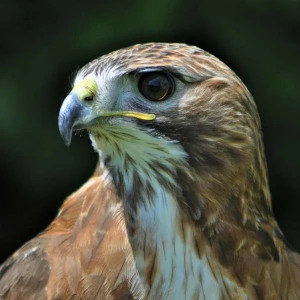
Shay
Shay is the larger male red tailed buzzard at the School. The red tail is the main bird of prey used for falconry in the USA, as they are larger and more powerful than our British common buzzard.
Shay is quite vocal, often croaking for more food even when he has had plenty. Shay belongs to a close friend of the School and he is popular at game fairs and displays, flying to adult participants.
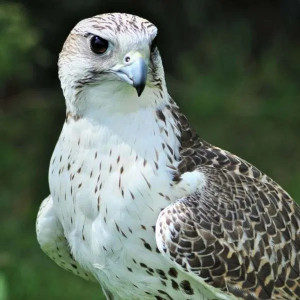
Wellington
Wellington is a gyr/saker hybrid. She is Ben’s favourite bird, and when he made falcon hoods for Harrods, she was his model. She the largest falcon we have at the School, weighing in at 2.9lbs (1.3kg).
She has been trained to fly to a lure on a kite and has flown up past 1400 ft. Out of all our birds, Wellington is the most likely to go for a wander. If the conditions are right (hot and windy), she may disappear for a while on a bit of a jolly. She also likes to chase red kites and herons if they appear in the air alongside her.
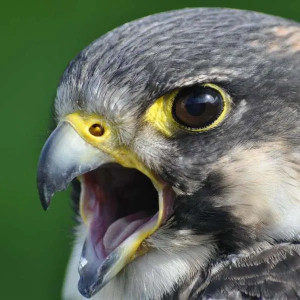
Ron
Sir Ronald Morris of Hardwicke is named after Ronald Stevens and the Honourable John Morris who bred the first hybrid falcon in 1971. Ron is a peregrine/saker.
The oldest bird at the School, Ron is quite a quirky bird. He is often more vocal than the others, calling to a female peregrine which occasionally flies over. He likes to take risks, so when flying at displays, Ron is often the bird people duck away from as he flies low and close to the crowd.
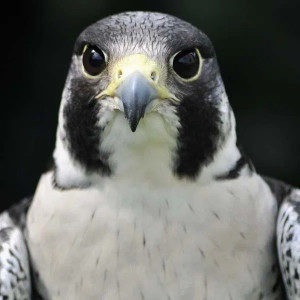
Coda
Coda is a Peale’s peregrine tiercel, the largest subspecies of peregrine which is found primarily in Alaska. Coda dislikes staff with dark hair (and dark hats). At the sight of them, he gets very excited and bates away from his block. He is gradually getting more comfortable with dark hair, but is still an excitable falcon.
Coda has been trained to chase a remote control plane, the HobbyKing Sonic 64. This aircraft tows a lure which, once caught, will deploy a parachute to bring him to the ground and prevent him flying away with the food.
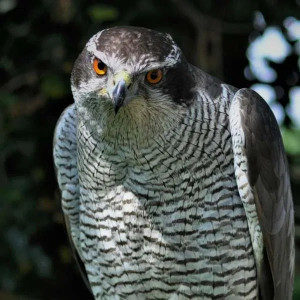
Clawed
Clawed is a male northern goshawk. We are very lucky that Clawed is content with flying to members of the public, as goshawks are generally a solo falconer’s bird due to their nervous disposition.
Clawed flies beautifully from person to person and displays expert agility flying through the tightest gaps out of trees and over visitors heads.
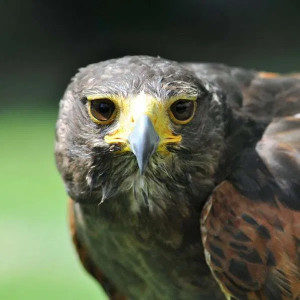
Snatch
Snatch is one of three male Harris hawks at the School. He is a very consistent performer and is flown at most public events we attend.
Snatch is missing two toes on his left foot, because when he was younger he had bad circulation and the only options were to euthanise him or remove the toes. So he is a couple of toes short, but still going strong. It doesn’t really hinder him, although on a windy day he might be a bit more slippery on the glove.
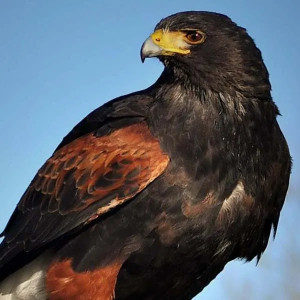
HB
HB is a male Harris hawk, who was bred at the Falconry School. He flies beautifully to participants at all kinds of shows and displays. HB stands for “Handsome Boy”, and was given to him due to his striking good looks.
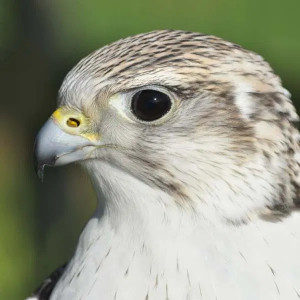
Cadbury
Cadbury is a male Gyr/Saker. He has a very excitable personality. He has been trained for several different disciplines and does well at each – until he reaches a point where he gets bored and no longer performs at his best.
He has recently come off his rest period and is being re-trained on the swung lure, before potentially beginning training on some of the remote control aircraft.
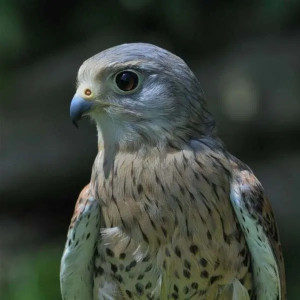
David
David is a male European kestrel. Kestrels have the unique ability to hover above their prey. They follow urine trails from rodents, which glow in the ultra violet spectrum that birds see in. Kestrels are often seen hovering over motorways, and conservation efforts have led to nest boxes being put on motorway signs.
David is trained to hover over the falconer’s pointed finger. Some days he performs better than others, but the wind can make a significant difference, as it is very energy-expensive to hover.
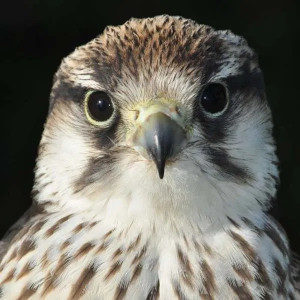
Zadok
Zadok is a lanneret (male lanner falcon). He was trained by John and is working on his fitness. He has impeccable manners and has already performed beautifully at several shows this summer.
Zadok flies to a swung lure (the traditional luring method). When hooded, Zadok persistently turns his head. Normally this would be a sign of stress, but with Zadok, it is just a habit.
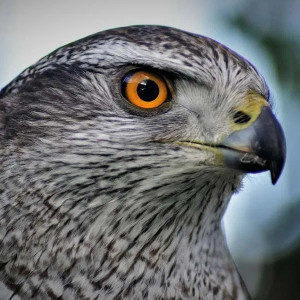
Dolly
Dolly is an imprint northern goshawk. Even though she was hand-reared, she is not as calm as Clawed and won’t normally fly to people she is unfamiliar with. However, she can give a brilliant display chasing after a dummy bunny, showing her immense power.
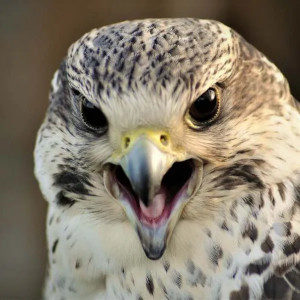
Cilla
Cilla is half peregrine, quarter gyr and quarter saker falcon. She is quite possessive of her food and can be slightly more aggressive to the person luring her, hence her nickname “Cilla The Killer”.
She is exceptionally fast and tactile, often flying into sunlight to blind the falconer swinging the lure. Cilla is our show-stopping bird, due to the way she stoops from directly above the falconer, providing a thrilling display of aerobatic skill.
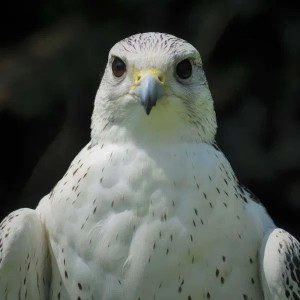
Martin
Martin is a gyr/saker hybrid. He is also trained to the “Robara” and is joining Diesel in training to chase the new “Rocrow”. When originally training, Martin was scared of the “Robara”, so we began by flying him to a piece of meat just on the head of the remote-control bird.
Martin is a slightly nervous bird, however he performs even better away from home.
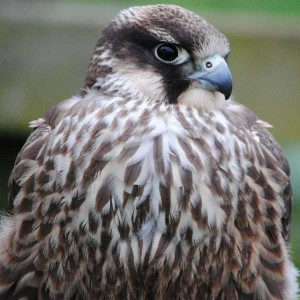
Pingu
Pingu is a peregrine/lanner hybrid. She is spectacular in flight, often choosing the tightest areas to fly through, by tucking her wings up into the typical teardrop shape.
We have recorded speeds of up to 60mph using GPS on Pingu. Although she has shown incredible aerobatic skills, she has also displayed rather bad manners, often trying to run away with the lure when she has caught it. She is getting better.
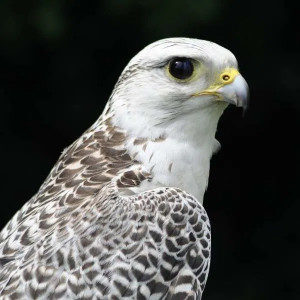
Toffee
Toffee is a gyr/peregrine/saker hybrid. He is trained to chase a remote control plane called the Hobbyzone Super Cub. The plane drags a lure which, once grabbed, deploys a parachute to bring the falcon to the ground safely.
Toffee also flies to a swung lure and has been used to fly in a cast (flown at the same time as another falcon) with his brother Garmin, who is no longer at the School.
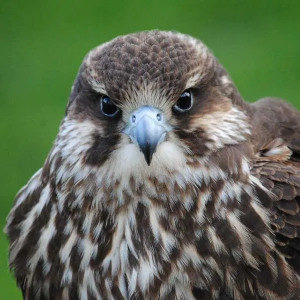
Diesel
Diesel is a female peregrine/saker falcon. She has been trained from an early age to chase the Wingbeat “Robara”, a recently developed remote-control aircraft in the form of a Houbara bird.
Originally designed as an alternative way of hunting in the Middle East to protect the Houbara population, it has proven to be an exciting new way of training falcons in the UK, too. A “Rocrow” has also been released, and we have been training Diesel onto this aircraft with spectacular results.
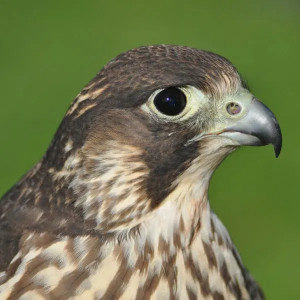
Corah
Corah is a female peregrine falcon. She has already proven that she’s a strong, powerful bird, causing plenty of damage to the RC aircraft she is trained to chase.
This behaviour has led to Ben planning to use Corah as a hunting bird to go grouse hawking. She is currently on her rest period, moulting her first year feathers and already looking much darker.
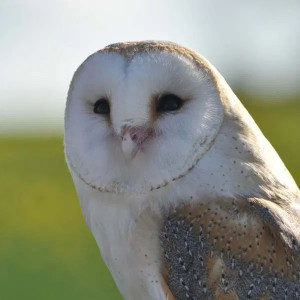
Cloud
Cloud is a female barn owl belonging to Head Falconer John. She was hand reared by John and sees him as Dad. She is very popular at displays poses for lots of photos, making her a favourite of many of our young visitors.
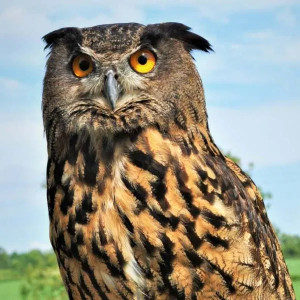
Uggy
Uggy is a European Eagle owl. She recently joined the Falconry School as her owner sadly fell ill. She has been settling in to the new area and we hope that once she has settled, she will join the flying team.
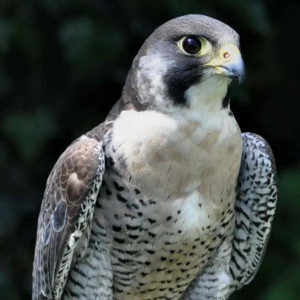
Dinky
Dinky is a British peregrine. He has a habit of lying on the floor like a pigeon when he is relaxed, although he gets quite nervous off site.
Dinky has been trained to fly to a lure on a kite, sometimes up to 800ft high. As well as flying to a kite, he is trained to go after a lure hanging from a drone.
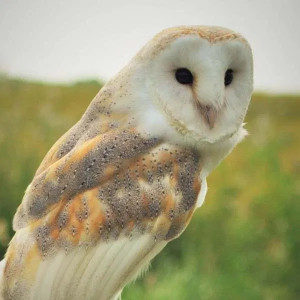
Willow
Willow is a barn owl who joined us with Uggy due to his owner’s ill-health. He settled in very quickly, and within a couple of weeks was flying free to members of the public.
He was handled a lot by his owner, which has led to him having a very friendly disposition. He has already made several popular appearances at shows and he will be attending more throughout the season.
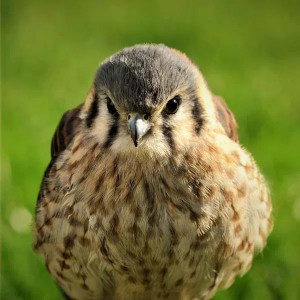
Thimble
Thimble is a hand-reared (imprinted) American Kestrel. Although small, she is fully grown at four and a half ounces (130g). Male American kestrels are about one third smaller than Thimble. They are used to hunt starlings, which are a pest species, in their native land.
Due to Thimble being hand-reared she has no boundaries, often landing on visitors heads and shoulders. She is adorable and very popular, however at dinnertime she turns into a little monster, trying to hide her food from staff in case we try to take it and eat it ourselves.
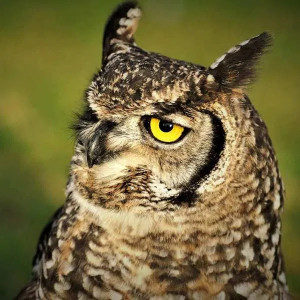
Bongo
Bongo is an African Spotted Eagle Owl. He doesn’t like having his feet touched, which can present a challenge when calling him in at the end of a display. Bongo is often keen to demonstrate his athleticism for visitors.
He is the bird most likely to let us down during displays, as he gets so easily distracted. His particular dislikes include horses and hot air balloons. These can be enough to render him stationary, with fixed eyes. He is quite a character but a consistent favourite for visitors.
